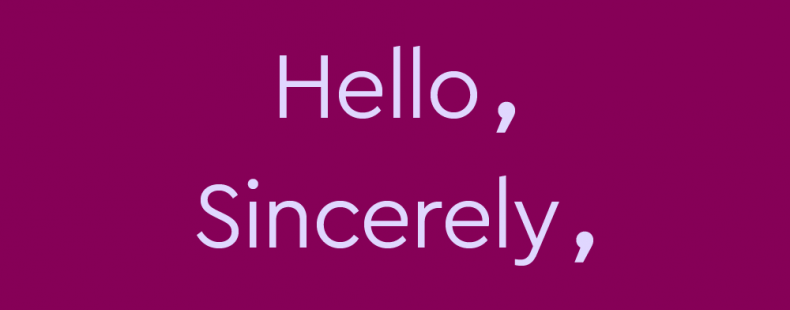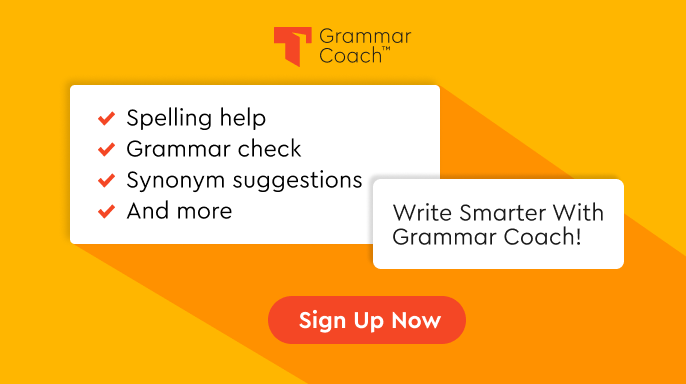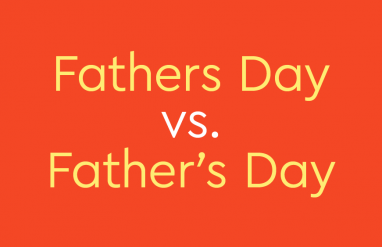Ah yes, the comma. This innocent-looking punctuation mark is often the bane of many writers who just can’t seem to get this mark to cooperate. The poor little guy probably doesn’t get too many holiday cards—hate mail, though, is a whole different story.
That might explain why this little troublemaker seems to enjoy messing up everybody else’s greeting cards. Often, the comma is mistakenly left out of many greetings and closings that it actually has every right to be a part of. Maybe, just maybe, if we learn how to properly use commas in greetings and closings, commas will stop making things so difficult for us in the rest of our writing—but we probably shouldn’t hold our breath.
Comma rules for greetings
Hello, comma, my old friend. When it comes to greetings and commas, there is one general rule that you should follow: place the comma after the greeting but before a person’s name. Regardless of what your greeting is, this rule will usually guide you to success. However, there is one common speed bump that might slow you down, which we will get to in a bit.
Comma after “Hello” and “Hey”
If you want to be friendly, a classic “Hello,” “Hey,” or “Hi” is always a good opener. When using any of these greetings, you should put a comma after them and before a person’s name. If using any of these by themselves as an interjection, you would simply end the sentence with whatever punctuation mark you would normally use.
Example:
✅ Correct: Hello, Abby!
❌ Incorrect: Hello Abby!
Comma after “Dear”
Now, we get to a common stumbling block. Firstly, whenever you use “Dear” to open a letter or other message, there is NOT a comma between “Dear” and the person’s name.
Example:
✅ Correct: Dear Santa, I want world peace and a Playstation 5 for Christmas.
❌ Incorrect: Dear, Santa, I want world peace and a Playstation 5 for Christmas.
✏️What’s the deal with “Dear?”
You’re probably wondering why “Dear” is—spoiler alert!—going to be the sole exception to the general comma rule. Well, it is because “Dear” isn’t actually being used as a greeting; it is being used as an adjective!
It’s true! For example, it makes sense to say “I am writing a letter to dear James” but it doesn’t make sense to say “I am writing a letter to hello James.” So, when you are opening a letter with “Dear,” you are actually giving someone a nice compliment.
Thinking about it that way, you’ll see that “Dear” isn’t the only word that won’t let a comma get between them and the person they care about. For example, you could open a letter with “Beloved Lisa,” “Darling Lyonel,” or “Cherished friends.” As you can see, none of these openers use commas before the names either. Of course, you will still need a comma after the entire opener when you transition into the main body of the message.
Comma before names
The reason behind all of this comma madness has to do with what is known as the vocative case. In grammar, the vocative case refers to a sentence that is directly addressing someone or something. When using the vocative case, it is considered proper grammar to separate out a person’s/animal’s/thing’s name using commas. For example, the following sentence uses the vocative case to directly address an inanimate object:
- Come on, blasted machine. Work!
Because greetings, salutations, well wishes, and goodbyes are often addressed directly to a person, we typically use a comma before a person’s name in order to properly use the vocative case.
Example:
✅ Correct: Great to see you, Daniela!
❌ Incorrect: Great to see you Daniela!
Comma after “Happy birthday”
Because you typically say “Happy birthday,” directly to someone, you would use a comma after the “Happy birthday” but before their name.
Example:
✅ Correct: Happy birthday, Dad!
❌ Incorrect: Happy birthday Dad!
Comma after “Good morning”
According to most grammar resources, the greeting “Good morning” should have a comma after it and before a person’s name, just like all other greetings. However, many people often get rid of the comma in informal letters and writing. So, don’t be surprised if you don’t see a comma clouding up someone’s “Good morning.”
Example:
✅ Correct: Good morning, Chris!
❌ Incorrect: Good morning Chris!
Comma after “Congratulations”
Although it doesn’t look like a “greeting,” the word “congratulations” is often said directly to a person in order to make them feel good about an accomplishment. In order to please our old friend the vocative case, we need a comma after “Congratulations.”
Example:
✅ Correct: Congratulations, Becky!
❌ Incorrect: Congratulations Becky!
Comma after holiday greetings
As with all other greetings, holiday greetings and well wishes are typically said directly to another person. That being the case, we once again need a comma according to the vocative case. This will be true no matter which holiday you and your friends are celebrating.
Example:
✅ Correct: Happy Halloween, Dr. Frankenstein!
❌ Incorrect: Happy Halloween Dr. Frankenstein!
✅ Correct: Happy Leif Erikson Day, Patrick!
❌ Incorrect: Happy Leif Erikson Day Patrick!
How do holidays get punctuated overall? Take a look at Valentine’s Day and others for examples.
Tips for commas and greetings
When it comes to greetings, commas aren’t too tough to use. To sum it up, just keep these tips in mind and you’ll be showing those commas who’s boss.
1. Direct greetings need a comma before a name
If you are saying a greeting directly to someone, you need a comma. This is true whether you are using it to begin a holiday card or shouting it from the mountaintops. Even if you are referring to people generally without using their name, you still need a comma if you are speaking directly to them. For example,
✅ Correct: Hello, my friends, and welcome to my humble home.
❌ Incorrect: Hello my friends and welcome to my humble home
2. “Dear” and other modifiers don’t need a comma
Words like “dear,” “beloved,” and “cherished” are adjectives, which means they are being used to modify a name rather than as a direct address. When used with a name, these words aren’t followed by a comma.
3. Greetings don’t need commas if not addressing someone
If a greeting or phrase is being used in general and not to directly address someone, you don’t need a comma after it. For example,
✅ Correct: I am going to wish Hector a happy birthday today.
❌ Incorrect: I am going to wish Hector a happy birthday, today.
Comma rules for closings
When writing letters (or postcards, emails, etc.), the typical advice is that you always follow a closing with a comma, regardless of what the closing is. Of course, informal writing may not always follow this rule, so don’t be surprised if your friends and family write comma-free letters to you every now and again.
Comma after “Thank you”
Example:
✅ Correct: … and that is why I deserve the award. Thank you, Dan ❌ Incorrect: … and that is why I deserve the award. Thank you Dan
Comma after “Sincerely”
Example:
✅ Correct: I hope we see each other again next year! Sincerely, Amanda
❌ Incorrect: I hope we see each other again next year! Sincerely Amanda
Comma after sign offs
Regardless of what word or phrase you use as a sign off, remember that you need a comma before you sign your name. If you decide to sign off your message with a complete sentence, you’ll often need to consult your letter-writing guide of choice to figure out what to do: it’s possible to use a comma, period, or even an exclamation point (in informal messages) to bring things to a close.
Example:
✅ Correct: … and that’s how I learned to avoid wild bears. Keep it real, Claude
❌ Incorrect: … and that’s how I learned to avoid wild bears. Keep it real Claude
Follow these tips for writing a thank you card.
Tips for commas and closings
Because the same rules apply, closings are going to have the same tips as greetings. This time, though, we don’t have that tricky “Dear” (or other adjectives) to worry about.
1. Closings that aren’t complete sentences need a comma
If you are closing with a single word or a phrase, you need a comma. For example,
✅ Correct: I’ll be home in time for the holidays. Love, Naomi
❌ Incorrect: I’ll be home in time for the holidays. Love Naomi
2. You can swap out a comma for an exclamation point in informal messages
Typically, you’d use either a comma or a period to close a formal message. Generally, you’ll only want to use an exclamation point when writing an informal message. For example,
Appropriate: Sounds great, bud. Looking forward to the big game! JT
Probably not appropriate: …which means the merger should proceed as scheduled. Looking forward to doing future business with you! Thaddeus Q. Wilimingshire IV, CEO
Are you ready to take this quiz on commas in greetings now?
Punctuate perfectly with Grammar Coach™
Confused about punctuation and its proper use? The Thesaurus.com Grammar Coach™ platform makes writing papers, essays, emails, and a whole lot more a whole lot easier. This writing tool uses machine-learning technology uniquely designed to catch grammar as well as spelling errors. Its Synonym Swap will find the best nouns, adjectives, and more to help say what you really mean, guiding you toward clearer, stronger, writing.















